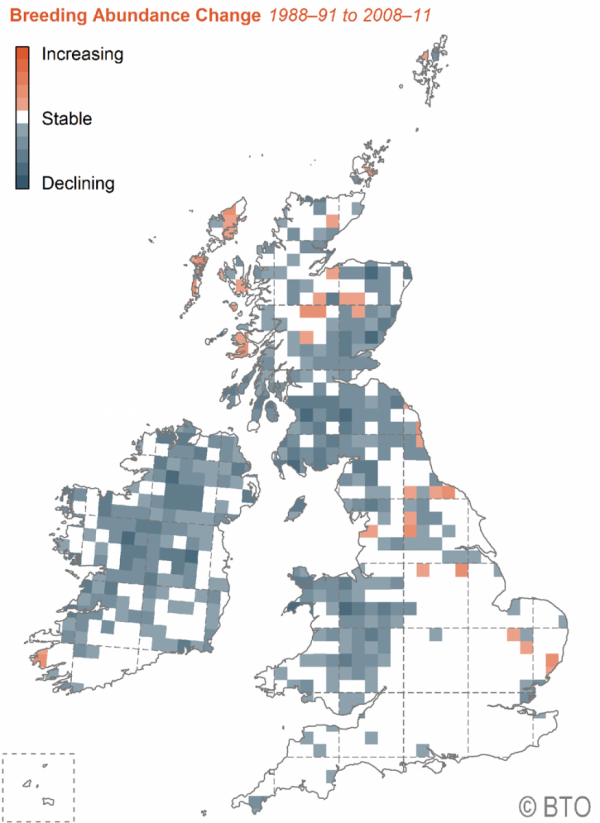BTO research into UK wader population declines will help suggest collaborative action to conserve them.
Following the launch of our Curlew Appeal in 2015, BTO has embarked on a programme of work to understand more about the causes of Curlew and other wader declines. By collaborating with individuals, organisations and communities across the UK, BTO will support conservationists, land managers and policy-makers to make the right decisions for breeding waders.

In 2015, Curlews were added to the UK Red List, following losses of nearly half their breeding numbers over the preceding 20 years. With the UK holding roughly 20-25% of the world’s breeding population of this globally near-threatened species, and hosting a fifth of the global population in winter, the status of UK Curlew populations presents a critical conservation challenge with global impact.
Following the launch of our Curlew Appeal in 2015, BTO supports a programme of work to understand more about the causes of Curlew and other wader declines, and to engage a wide suite of stakeholders in monitoring wader populations. Working with others, this will enable us to assess what factors will enable population recovery, where conservation efforts should be targeted, and empower local communities to understand how they can facilitate conservation of ‘their’ wader populations.
BTO’s monitoring data has proved invaluable for understanding the drivers of declines of both breeding and wintering Curlew populations in the UK.
Using BTO monitoring data to understand declines
BTO’s monitoring data has proved invaluable for understanding the drivers of declines of both breeding and wintering Curlew populations in the UK. Supported by funding from the BTO/JNCC/RSPB Breeding Bird Survey (BBS) partnership and the Curlew Appeal, we published the first assessment of the causes of breeding Curlew decline across Britain (Franks et al. 2017). Using BBS data, this study identified habitat as a key driver of both Curlew abundance and population change. High breeding densities were associated with semi-natural grassland and moorland habitats, with lower numbers and greater population declines in areas with more arable farming and woodland in the surrounding landscape. There was also strong evidence that generalist predators such as Foxes and Crows limit Curlew populations, while results suggested at least some aspects of gamebird management could have a beneficial impact, with positive associations between numbers of Curlew and gamebird species. We also found evidence that Curlews have declined most in warmer, drier parts of the UK, suggesting that this species is vulnerable to climate change.

Bird Atlas data showing breeding abundance change in Curlew, 1988-91 to 2008-11.
Evidence from localised breeding studies across the UK indicates that the main mechanism driving Curlew population declines is poor breeding success, due to losses of nests and chicks to either predation or agricultural activities. Evidence from a recent BTO analysis of ringing data being reviewed for publication, confirms that adult survival rates of breeding Curlew are high (roughly 90%), and is consistent with poor productivity being the main cause of current declines. This provides an imperative for conservation efforts to focus on boosting nest and chick survival to stabilise populations and enable recovery. It also demonstrates the vital importance of maintaining high adult survival rates, with reduced survival posing the threat of even faster population declines. This highlights the potential risk posed by the end of the moratorium on hunting non-breeding Curlew in France for any UK breeding birds that winter there.
In addition to identifying the causes of population declines, we have also used Bird Atlas 2007-11 data to identify ‘hotspots’ for Curlews and other waders at a 1 km resolution across Britain. These ‘sensitivity maps’ can be used to target conservation activities and, importantly, to inform other environmental activities which have the potential to affect waders. For example, forest expansion and the creation of new woodlands are either actively underway or planned in many areas of the UK, delivering many environmental and conservation benefits. However, reforestation could further adversely impact breeding waders, highlighting the need for any forest expansion to take place as part of an informed, joined-up land use strategy.
-28
Population trends 1995-2007 (BBS data) (%) | |||||
| Species | UK conservation status | UK | England | Scotland | Wales |
| Curlew | Red-listed | -48 | -30 | -61 | -68 |
| Lapwing | Red-listed | -42 | -55 | Unavailable | Unavailable |
| Oystercatcher | Amber-listed | 23 | 47 | -38 | Unavailable |
| Redshank | Amber-listed | -44 | -46 | Unavailable | Unavailable |
| Snipe | Amber-listed | 32 | 26 | 64 | Unavailable |
Revealing habitat requirements in detail
BTO’s monitoring data have improved our understanding of the broad drivers of breeding Curlew population declines. However, recent work has allowed us to start building a more detailed picture of what habitat we will need to deliver across UK landscapes for Curlew to thrive.
In Wales, GPS tracking over three years has shown that Curlew breeding in different landscapes have different habitat preferences, using a mosaic of habitats throughout the breeding season (Taylor et al. 2020). Furthermore, breeding birds vary widely in the size of their home range. This suggests that agri-environment measures to benefit Curlew will need to operate not at the field- or farm-scale, but at the landscape-scale, requiring a community approach to land management.
A current PhD project partnership between the University of East Anglia and BTO is further contributing to our understanding of exactly what Curlew need to successfully fledge chicks. This project, studying the breeding Curlew population in Breckland, aims to identify the factors important for nest survival, and to investigate the specific vegetation requirements important for chick survival from hatching until fledging.
Understanding the impact of conservation actions
Species conservation must be underpinned by an understanding of the causes of decline and species’ habitat requirements. However, it is also important to test population responses to changes on the ground.
Reviewing published assessments of wader population responses to conservation action, we found evidence of positive responses to most of the standard interventions in the conservation ‘toolkit’, including higher tier agri-environment measures targeted specifically at breeding waders (Franks et al. 2018). Notably, however, Curlew was one of the only species that did not appear to benefit from most measures, suggesting that their current implementation is not benefiting Curlew as expected.
For population recovery to succeed, there needs to be significant further study to understand exactly which measures benefit Curlew and why. While most studies investigated the impact of conservation actions on abundance, population trends, or nest survival, few examined the effects on chick survival. Given that this may be a key factor limiting population recovery, we advocate the need for further research to investigate this critical life stage.
Working in partnership
We are now focusing on the need to support the wide range of conservation activity across the UK for Curlew and other breeding waders — specifically to inform the effective monitoring of the impact of those conservation actions. Only by doing this can we truly understand what works and make sure that we are using conservation resources most efficiently for these species.
BTO has recently published an audit of projects undertaking monitoring and conservation action for breeding waders in the UK and Ireland (Wilson et al. 2020), and guidance to inform the monitoring of breeding waders. Thanks to funding from our recent Operation Wader Appeal, we have now employed a Wader Project Officer to strengthen and support the involvement of local poeple in wader management and conservation, and to foster collaboration between different groups of stakeholders. The Project Officer will also seek to encourage the development and uptake of methods for monitoring breeding waders that are suited to these different groups, which will yield useful data.
A key aim for BTO is to work with partners to develop systems and processes for capturing, storing and accessing these data. This will help engage with local communities interested in monitoring their wader populations and, critically, will also enable stakeholders, scientists and policy-makers to find and use the data they need to better understand the needs of our breeding wader populations. Ideally, it will ultimately also lead to opportunities to address landscape-scale questions about management through a coordinated, iterative process of action, followed by feedback to inform and adapt further action.
A lot has happened since Curlew was added to the UK Red List in 2015, with the conservation community, local stakeholders, and wider public galvanised by the plight of this and other wader species. BTO has significantly improved our understanding of Curlew declines, and deployed the available information to identify a range of evidence-based conservation and monitoring solutions. However, conservationists, land managers and policy-makers urgently need better information about how best to spend limited resources on actions that are optimised to the relevant landscapes, regions and stakeholders. By collaborating with individuals, organisations and communities across the UK, BTO will support these partners to collect and mobilise information that can be used to address these knowledge gaps, and deliver the advice that society needs to make the right decisions for our Curlews and other breeding waders.
Staff Contact(s)
James Pearce-Higgins
Director, Science

Mark Wilson
Head of Science Scotland

Samantha Franks
Senior Research Ecologist

Paul Noyes
Wader Project Officer

Related Publications
- Audit of local studies of breeding Curlew and other waders in Britain and Ireland
- BTO Research Report. No. 727. British Trust for Ornithology, Thetford, UK.